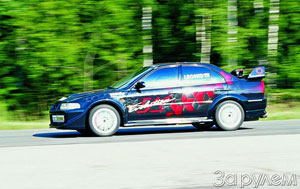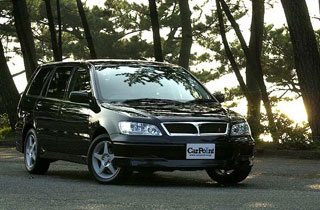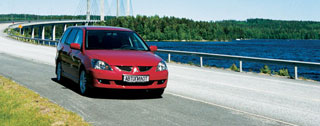Test drive Mitsubishi Lancer Evolution VIII 2003 - 2005 sedan
Black and white
 Mitsubishi-Lenser Evo VI in extreme versions
Mitsubishi-Lenser Evo VI in extreme versions There is no power - otherwise why do cars become more powerful from year to year? And certainly, the race behind the horsepower is a call to the ambition of lovers and professionals of tuning. In our hands are two Mitsubishi Lancer Evo VI. Yes, not quite simple - according to the assurances of their creators from the sports car, under the hood of a black car there are 380 horses, and in white - 430. What to call them? Well, let it be so: black and white.
Build!
 So, the first is black. Mitsubishi Lancer Evo VI Tommy Myakinen Edishn - this is his full name. It is distinguished from the usual EVO VI is distinguished by a more developed front spoiler and the presence of ABS brakes and AYC (Automatic Yaw Control) - a controlled rear differential. We already wrote about this car (ZR, 2000, No. 12), but then there were only 280 forces under the hood. Now exactly a hundred has been added. Yes, with a working volume of the engine, 380 horses are squeezed slightly less than two liters from it. How? A runaway external inspection discovers a more free exhaust system of increased diameter and ... that's it? Of course, no - everything else is hidden under the hood. The turbocharger and the intermediate cooler remained the same, but the inlet system of the Japanese company HKS is completely new, from an air filter with reduced resistance to inlet manifold. Aluminum pipes of increased diameter and bypass valve with
So, the first is black. Mitsubishi Lancer Evo VI Tommy Myakinen Edishn - this is his full name. It is distinguished from the usual EVO VI is distinguished by a more developed front spoiler and the presence of ABS brakes and AYC (Automatic Yaw Control) - a controlled rear differential. We already wrote about this car (ZR, 2000, No. 12), but then there were only 280 forces under the hood. Now exactly a hundred has been added. Yes, with a working volume of the engine, 380 horses are squeezed slightly less than two liters from it. How? A runaway external inspection discovers a more free exhaust system of increased diameter and ... that's it? Of course, no - everything else is hidden under the hood. The turbocharger and the intermediate cooler remained the same, but the inlet system of the Japanese company HKS is completely new, from an air filter with reduced resistance to inlet manifold. Aluminum pipes of increased diameter and bypass valve with  reduced resistance was allowed to increase the pressure pressure from 1.2 to 1.5 atm. More air - more fuel. The standard place was taken by the HKS fuel system with nozzles increased by 20% of performance and additional pumping pump. However, there are changes under the valve lid. Here are new camshafts, more rigid valve springs. The new pistons and connecting rods from the HKS Core kit are even deeper - the initial for crossing the motor. Here, in fact, is the whole secret. Only the front shock absorbers of Ols remained to improve controllability.
reduced resistance was allowed to increase the pressure pressure from 1.2 to 1.5 atm. More air - more fuel. The standard place was taken by the HKS fuel system with nozzles increased by 20% of performance and additional pumping pump. However, there are changes under the valve lid. Here are new camshafts, more rigid valve springs. The new pistons and connecting rods from the HKS Core kit are even deeper - the initial for crossing the motor. Here, in fact, is the whole secret. Only the front shock absorbers of Ols remained to improve controllability. White is charged much more serious. In addition to everything that is on a black car, there is a more productive Garret-HKS GT with a bypass valve not only on the compressor, but also on the turbine and the exhaust pipeline with an optimized length of the pipes. Theoretically, such a combination allows you to remove up to 490 liters. s., but its capabilities were slightly limited to more reliability of the engine. The boost pressure here is the same (1.5 atmospheric), but the radiator of the intermediate cooler is much larger. As a result of the characteristics of the motor are completely different, including
 and thanks to the controller of the MOKET, which allows you to configure the parameters of injection and boost for specific conditions within a fairly wide limits. Of the highlights, it is worth noting a turbotimer that allows the engine to work after the ignition key is pulled out, and the throttle actuator: it is able to independently make overdoses when switching down or adding speeds before touching - an extremely pleasant thing. On the dashboard along with a standard set is an ADL liquid crystal indicator, not only showing, but also fixing the motors and operation modes.
and thanks to the controller of the MOKET, which allows you to configure the parameters of injection and boost for specific conditions within a fairly wide limits. Of the highlights, it is worth noting a turbotimer that allows the engine to work after the ignition key is pulled out, and the throttle actuator: it is able to independently make overdoses when switching down or adding speeds before touching - an extremely pleasant thing. On the dashboard along with a standard set is an ADL liquid crystal indicator, not only showing, but also fixing the motors and operation modes. The suspension has little standard: starting with tougher silent blocks from the rally art to the racks of the Profilex for asphalt special stages equipped with shock absorbers with a remote tank. And yet ... however, you can list for a long time. External differences are also visible in the photo.
 To start, attention ...
To start, attention ... Behind the story of the engines, they almost missed the transmission. The weak point of Evolyusen is clutch. In general, there is enough for a calm ride, but who buys such cars for a calm ride? Our couple has a HKS two -aramed two -disc adhesions. Not a gift for parking, but you can safely spin the engine up to 7500 rpm and release the pedal - the clutch will withstand.
Now - to the gearboxes. On both machines there are boxes with a nearby stretched at maximum speed. On the black transfer of the main pair 4.53 - such a combination is used on asphalt rally dopa. On a white car - 4.1 - theoretical maximum speed at 7000 rpm should be 265 km/h. And what happens in practice? Go!
Faster fast
To say that Black Mitsubishi quickly accelerates is to say nothing. This car accelerates fantastically quickly: 3 seconds - 80 km/h, 10 s - 160 km/h, 25 s - the operation of the speed limiter in the fifth gear. A little more than a kilometer has been passed, a speed of 235 km/h has been reached. Words cannot be described. Only after you understand that the fastest gear shifts last, and the stomach that sticks to the back is not a metaphor.
What to expect from a car, under the hood of which is 50 more for more? Nothing special: a hundred - a little more than 6 seconds, 140 km/h - in 10. Only after a kilometer mark, the White Mitsubishi will catch up black and playfully go into the gap, calming only on the sky -high 280 km/h. Why can't a rocket launch? The answer is given by the laptop connected to the ADL, and the readings of our devices. Alas, the 430-horsepower engine is too weak. No jokes. The problem is that the contribution of a turbocharger here begins to be felt only after 5000 rpm. (For comparison: in the black car this threshold is 3000 rpm.) And the supply of fuel is already overlapping at 7500. You can’t do it anymore - the crankshaft will not stand it. In reality, at the start, the speed falls up to 4200, and the full pressure of the boost after such a failure is restored only to 7000 rpm.
 Further, of course, things are better. In second gear, the compressor is already caught at 6,000, and on the fifth at 5200 rpm, but the failure at the start is inevitable, and the long main pair and wider tires only exacerbate the situation. In general, you want a missile start - put a short pair.
Further, of course, things are better. In second gear, the compressor is already caught at 6,000, and on the fifth at 5200 rpm, but the failure at the start is inevitable, and the long main pair and wider tires only exacerbate the situation. In general, you want a missile start - put a short pair. Nevertheless, the contrast of the character of the White Mitsubishi is amazing. Up to 5000 revolutions, he behaves as an ordinary passenger car with very ordinary dynamics. And after ... it is useless to keep the hat, and the helmet - do not forget to fasten. Perhaps the only problem is that the turn at a speed of 50 km/h will have to be held in the first gear ... It is extremely difficult to use the potential of a white machine on a winding highway, since the operating range of the motor is very narrow. But the chassis completely allows - hard elastic bands and shock absorber racks provide an amazing sense of road, with all positive and negative features. And on the straight line there is where to walk around. That's just the start to fix it ...
Instead of example
 As you can see, record power values \u200b\u200bdo not always guarantee the best dispersal indicators. When it comes to an almost racing motor with a very narrow working range, much more important gear rates, the selection of optimally working tires and a good clutch that can withstand extreme mode. Yes, the peak values \u200b\u200bof power and torque are not at all the main indicator - you need to know how the moment is distributed in the entire speed range. After all, it may happen that the range in which the car is traveling is unacceptable not only for everyday use, but also for a specific race. According to the creators, the White Lancer lacks a more durable crankshaft so that the motor is spinning to 8200-8500 rpm ...
As you can see, record power values \u200b\u200bdo not always guarantee the best dispersal indicators. When it comes to an almost racing motor with a very narrow working range, much more important gear rates, the selection of optimally working tires and a good clutch that can withstand extreme mode. Yes, the peak values \u200b\u200bof power and torque are not at all the main indicator - you need to know how the moment is distributed in the entire speed range. After all, it may happen that the range in which the car is traveling is unacceptable not only for everyday use, but also for a specific race. According to the creators, the White Lancer lacks a more durable crankshaft so that the motor is spinning to 8200-8500 rpm ... This is very interesting to construct sports cars and cars for drivers with high requirements. Many pitfalls are hidden on this path, which is not easy to learn to bypass. What once again confirmed a black and white couple of Lancers.
This is not a Tommy Myakinen seat, but he approves this (on the left).
The same model of the recar, but without an autograph - side support is provided not only by the lower back, but also to the shoulders (right).
Here only 380 liters. With. (left).
This motor added 150 liters. With. (on right).
The oil temperature indicator and voltmeter will not be superfluous.
New air filter and compressor bypass valve.
Bypass (bypass) turbine valve.
The posterior anti -wing on the zero angle of attack. The race is completed, the average speed in two directions is 278.8 km/h.



Anatoly Fomin
Photo: Konstantin Yakubov
Source: The magazine "Driving"








